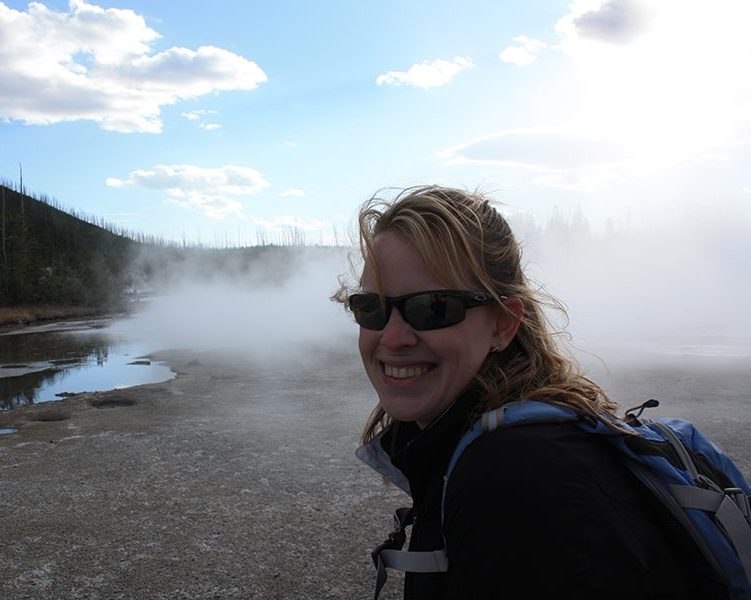Feeling your knee pop ranks on the list of Top 10 Terrifying Moments, right next to feeling the lava give way beneath your boots, or facing a starving tiger. In that split second after it pops, all sorts of frenzied things race through your mind. “That’s it! I’m done for! I’ll never walk again!”
Lucky for me, I wasn’t 12 miles up a lava field when it happened. I was just standing around, talking story. Yes, I am talented enough to hurt myself while standing still. It takes real skill to do that. But the truth is, this injury was a long time coming.
The pain made an appearance in my right knee a full year before the pop! It was uncomfortable when I hiked or ran, but it wasn’t the worst pain I’d ever felt. I hiked 100 miles over volcanic terrain last year, but never got it checked out. Despite my best efforts, my IT Band (the muscle that runs along the outside of your thigh) kept getting tighter and tighter. The muscles on the insides of my legs that balance it out just couldn’t keep up. So, this February – Pop! My IT Band ripped my kneecap right out of joint.
The symptoms masked themselves as a miniscus injury, so it took 6 months to figure out what acutally went wrong. Finally, in July, I had a patellofemoral realignment surgery. What a mouthful, right? The short of it is that the doctor had to cut a slice of bone out to rebalance my leg, reset my knee, and then he screwed the pieces down. It sucked. I was on crutches for 8 weeks (my upper body strength can now rival that of the Hulk!) and in a brace for 10. I still have 8 weeks of physical therapy to tackle. Needless to say, no volcano hopping for me this summer. And that in itself has been worse than all the pain.
But it gave me a long time to think about injuries. How many of you, my friends, have suffered something similar? Or might battle this in the future? And how many of those injuries might be prevented?
I sat down with my physical therapist and asked what a person who does a lot of running and/or hiking could do to prevent an injury like this. Together, we compiled a list of helpful hints that might prevent an injury like what I’ve experienced from happening to you.
Now, keep in mind that I am not a doctor, nor am I a physical therapist. I’m just a volcano enthusiast. If you have questions or concerns about your own health, please call your doctor. But hopefully, these tips will start you down a positive path to staying healthy and injury free on your adventures!
Your mission, should you choose to accept it: There are a zillion different stretches and exercises for each of the tips and tricks below. I’ll list a few of my faves, but jump on Google and do some additional research. Talk to your own physical therapist, or the personal trainer down at your gym. Start a routine and stick to it!
Before Your Boots Hit the Ground
On your off days (days that you’re not on the trail), you need to be stretching and strengthening your entire body! Your legs do not work alone when you’re out on a trek, and if your whole body is strong and in sync, it will make the hike easier and hopefully reduce any injuries you might experience
1. Balance Exercises
It is critical for you to do balance exercises, especially if you’re going to hike over tricky landscapes. I’ve found these are critical for hiking over lava flows. Lava is wickedly uneven and one tip to the right or left can result in a twisted ankle or bloodied limbs. But these exercises will also strengthen and activate muscles you didn’t even know you had.
Volcano Hopper’s favorite balance exercises:
– Stand with one foot on the ground. Keep the second foot off the ground but in a “kickstand” position in case you wobble and need some extra support. Keep your hands around belly-level. Look to your right, then to your left like you’re window shopping. Too easy? To make it harder, stand on a pillow or a sofa cushion.
– Stand on one foot. Lift up onto the ball of that foot. This stretches your calf muscles like you wouldn’t believe.
– If you have one of those Bosu balance trainers (they look like ½ of an exercise ball), you can use it for a million different balance exercises. You can even do squats on it. This is a great tool to simulate uneven ground. If you don’t want to buy one, your local gym will usually have one that you can borrow during your workout routine.
2. Strengthening Exercises
It’s super-critical that you strengthen your whole body on days when you’re not hitting the trail. I’ve found time and again that I do better on a run or hike if I’ve been following my routine, especially my core work.
During these exercises, you can do a lot of work to ensure that all of your muscles are strengthened equally. If one becomes stronger than the other (like my IT Band did), it can cause injuries. Make sure to work your feet, calves, glutes, hips, and core. Mix up your routine to keep it exciting. And be sure to look up online or talk to your gym’s trainer to find the best fit for you.
Volcano Hopper’s favorite strengthening exercises:
– Using an elastic band for resistance, lie on one side and open your legs from the hip like a clamshell. This helps strengthen the hips.
– Keeping the elastic band on, do crab walks back and forth across the room. Keep your knees bent as you step. You can also do this on a treadmill that is steeply inclined for more resistance.
– Exercise balls can be used for a plethora of strengthening exercises too, especially core. Lie on your back, with both feet up on the exercise ball. Raise your hips as high as you can, roll the ball in toward you with your feet, then push it back out. Repeat. Want to make it harder? Cross one ankle over the other so that all your balance is on one leg.
– The treadmill is a great tool as well. You can incline it steeply to do slow crab walks (you turn to the side for this and hold on!) or you can walk backward while keeping it at an incline. This will work different parts of your lower body.
– Agility exercises are a fun and important way to keep yourself on your toes. Turn up the music and do some dance moves like the Ickey shuffle. My physical therapist has what looks like a rope ladder that he puts out on the floor. I do all sorts of complicated footwork through it, forward and back. Do it as slowly or as quickly as you are comfortable with.
– Plyometrics are training while incorporating jumps. I’m not doing many of these right yet with my legs, but a favorite is the leg press. I can do a very slow, controlled jump while strengthening my leg muslces. Do some research to find out which ones will be most beneficial for your routine.
Getting out on the Trail
1. Dynamic Stretching
So you’ve been strengthening your muscles all week and you’re ready to hit the trail! You get out of the car and are itching to run to the trailhead. But there’s something you must do first: warm up! Cold muscles are prone to injury.
The best way to get your body ready to move is to move it! Dynamic stretching is moving your muscles into a good stretch, but not holding them in place. Remember those static stretches you used to do in gym class? The ones where you stretch and hold it for 30 seconds? The days of stretching like this before a workout are dead and gone. Doing this before a run or a hike can actually hinder you. Save those static stretches for afterward.
Volcano Hopper’s favorite dynamic stretches:
– Lunges: Do a lunge with one leg forward, the other behind. Bend your knees. Twist from left to right at the waist, then stand up, bringing your feet together. Switch legs. Repeat. You can even make this a fun game of red light/green light if you’re with some pals on your way to the trailhead.
– Front kicks with hand reaches: Kick your leg up straight out in front of you. Try to touch the palm of your hand to your toes. Switch legs and repeat.
– Squats
– Rotate ankles/toe taps: A little trick I learned in Irish dance to prevent shin splints. Rotate your ankles by drawing circles with your toes clockwise, then counter clockwise. Tapping your toes side to side can also help reduce the likelihood of shin splints.
4. Post-Hike
It’s so tempting after a long hike to sit down on the nearest available object. Your feet hurt, your body hurts, and you’re just flat out pooped. Don’t yield to the temptation or you’ll be sitting on that object until someone comes to pry you off of it. Your muscles will cool down and freeze in position. You need to let them down gently.
Volcano Hopper’s favorite post-hike stretches:
– Static stretches: Find a stretch position and hold it for 30 seconds to 1 minute.
– Yoga stretches: I like to incorporate some yoga stretches at the end of a hike, especially for my lower back. Downward dog and Child’s Pose are two of my favorites.
– Foam Roller: If you’re able to get onto a foam roller (I heard that groan!), definitely do. Or find one of the hand-held rollers that creates the same effect. I know that foam rolling can be mighty painful, but it’s critical to release some of that tightness in your muscles. Especially that IT band of yours. Make it hurt so good.
Remember, this is a super-brief summary of everything you can do to strengthen your body and prevent injuries on your adventures. There’s a wealth of knowledge out there on this topic, so please do some research!
Stay happy, healthy, and safe out there. Happy Hopping!
Copyright © 2018 Volcano Hopper. All rights reserved.



Hello, you used to write excellent, but the last several posts have been kinda boring… I miss your tremendous writings. Past several posts are just a little bit out of track! come on!